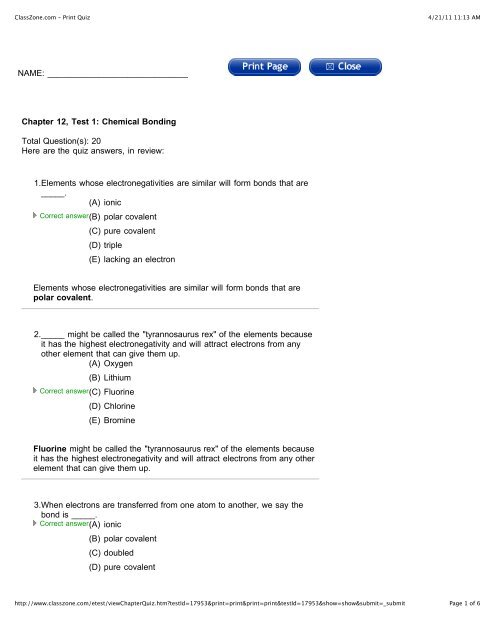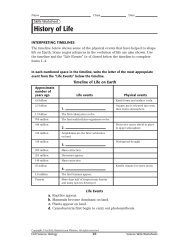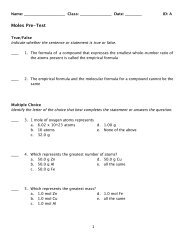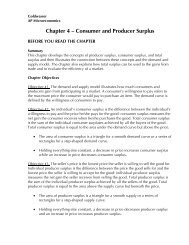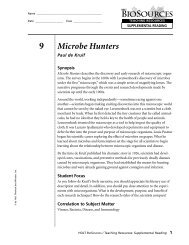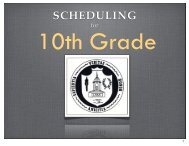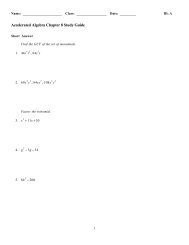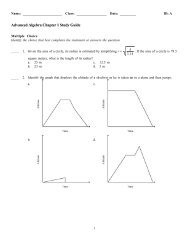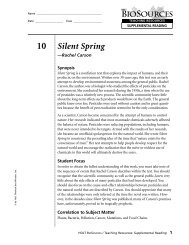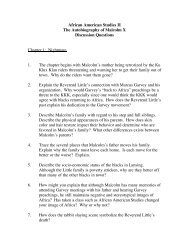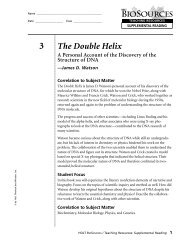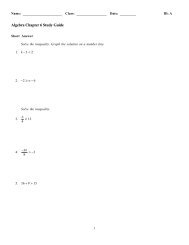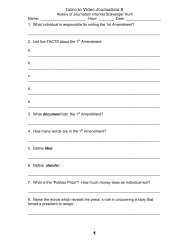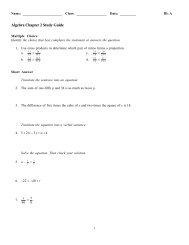Chapter 12 Practice Quiz 1 With Answers.pdf
Chapter 12 Practice Quiz 1 With Answers.pdf
Chapter 12 Practice Quiz 1 With Answers.pdf
Create successful ePaper yourself
Turn your PDF publications into a flip-book with our unique Google optimized e-Paper software.
ClassZone.com - Print <strong>Quiz</strong>4/21/11 11:13 AMNAME: ______________________________<strong>Chapter</strong> <strong>12</strong>, Test 1: Chemical BondingTotal Question(s): 20Here are the quiz answers, in review:1.Elements whose electronegativities are similar will form bonds that are_____.(A) ionicCorrect answer(B) polar covalent(C) pure covalent(D) triple(E) lacking an electronElements whose electronegativities are similar will form bonds that arepolar covalent.2._____ might be called the "tyrannosaurus rex" of the elements becauseit has the highest electronegativity and will attract electrons from anyother element that can give them up.(A) Oxygen(B) LithiumCorrect answer(C) Fluorine(D) Chlorine(E) BromineFluorine might be called the "tyrannosaurus rex" of the elements becauseit has the highest electronegativity and will attract electrons from any otherelement that can give them up.3.When electrons are transferred from one atom to another, we say thebond is _____.Correct answer(A) ionic(B) polar covalent(C) doubled(D) pure covalenthttp://www.classzone.com/etest/view<strong>Chapter</strong><strong>Quiz</strong>.htm?testId=17953&print=print&print=print&testId=17953&show=show&submit=_submitPage 1 of 6
ClassZone.com - Print <strong>Quiz</strong>4/21/11 11:13 AM(E) lacking an electronWhen electrons are transferred from one atom to another, we say the bondis ionic.4.The symbol used to indicate a partial charge separation in a polarcovalent bond is _____.(A)(B)(C)Correct answer(D)(E)The symbol used to indicate a partial charge separation in a polar covalentbond is .5.If there are pure covalent bonds in a molecule, the molecule can bepolar.(A) trueCorrect answer(B) false"If there are pure covalent bonds in a molecule, the molecule can be polar"is false.6.Ionic compounds are most likely to be formed between _____.Correct (A) metals and nonmetalsanswer(B) metals and metals(C) nonmetals and nonmetals(D) metals and semimetals(E) nonmetals and semimetalsIonic compounds are most likely to be formed between metals andnonmetals.7.The relative ability of an atom in a molecule to attract electrons to itselfis called _____.(A) ionization potential(B) metallic character(C) electron affinityhttp://www.classzone.com/etest/view<strong>Chapter</strong><strong>Quiz</strong>.htm?testId=17953&print=print&print=print&testId=17953&show=show&submit=_submitPage 2 of 6
ClassZone.com - Print <strong>Quiz</strong>4/21/11 11:13 AMCorrectanswer(D) ionization energy(E) electronegativityThe relative ability of an atom in a molecule to attract electrons to itself iscalled electronegativity.8.The lowest electronegativities are found in the _____ of the periodictable.(A) upper leftCorrect answer(B) lower left(C) upper right(D) lower right(E) middleThe lowest electronegativities are found in the lower left of the periodictable.9.The greater the difference in electronegativities between two atoms, themore likely the bond between them will be _____.(A) partially formed(B) very weakCorrect answer(D) ionic(C) pure covalent(E) polar covalentThe greater the difference in electronegativities between two atoms, themore likely the bond between them will be ionic.10.If the centers of partial positive charge and partial negative chargecoincide (are in the same place), the molecule is polar.(A) trueCorrect answer(B) false"If the centers of partial positive charge and partial negative chargecoincide (are in the same place), the molecule is polar" is false.11.Water is such a good solvent because its _____ allow(s) it to beattracted to polar or ionic solutes.(A) bondsCorrect answer(B) polarityhttp://www.classzone.com/etest/view<strong>Chapter</strong><strong>Quiz</strong>.htm?testId=17953&print=print&print=print&testId=17953&show=show&submit=_submitPage 3 of 6


